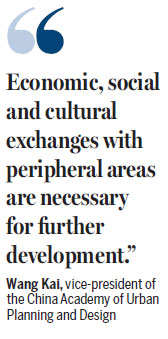Coordinated action is vital to tackling big city malaise
Beijing will stress coordinated development of its surrounding regions in the coming years, to solve the challenges brought about by a "big city malaise," experts said.
Approved by the Party's Central Committee and State Council, the city released a development plan covering 2016-2035 in late September to outline its role, function and goal as China's capital, to better construct a global, harmonious and livable city.
Wang Kai, vice-president of the China Academy of Urban Planning and Design, said the blueprint planned for the capital to forge even closer links with the nearby city of Tianjin and northern Hebei province, conforming to the general development paths of big cities around the world, such as London, Tokyo and Paris.
"The Beijing-Tianjin-Hebei region has natural cultural and emotional links due to the geological location," he said.
"Economic, social and cultural exchanges with peripheral areas are necessary for further development."

In this sense, Xiong'an New Area in Hebei province, relieving the non-capital functions of Beijing, is the new growth point of the region, said Li Xiaojiang, a member of the Beijing-Tianjin-Hebei coordinated development expert consultation committee.
A major path to Beijing's development lies in the construction of a sub-center in the outskirts of Tonghzou district and Xiong'an New Area, Li said.
Ye Yumin, director of the academic committee of the School of Public Administration of Renmin University of China, said solving the problems of the huge city reflected the common wish of the country and its citizens.
The Beijing development plan tackled the major challenges, optimized the overall circumstances and provided tailored measures to construct a better Beijing, which would lead to the strategic development of the city, Ye said.
Ke Huanzhang, vice-president of the China Association of City Planning, said one breakthrough of the plan suggested a control, instead of an increase, in terms of its population and construction areas.
The city aims to hold its population to 23 million by 2020, with 10.85 million in its six core districts. The number of registered residents now stands at 21.73 million.
The land used for construction will be reduced from 2,921 square kilometers in 2015 to 2,860 sq km by 2020, and be further cut to 2,760 sq km by 2035, according to the new plan.
Ke said the implementation of development "red lines" were expected to solve Beijing's problems with the use of clear management and regulation methods.
Shan Jixiang, president of the Palace Museum, said the plan had a broad vision for the old and central areas, and the urban region covering up to 16,410 square kilometers, from Beijing to Tianjin.
"It has laid the foundations for the protection of a historically and culturally famous city," Shan said.
The plan, comprising eight chapters and 60,000 words, focuses on the positioning, spatial layout and protection of Beijing's history. It balances the needs of its urban and rural areas with regionally coordinated development, he said.
Shi Weiliang, president of the Beijing Municipal Institute of City Planning and Design, said the plan was based on the key question: "What kind of capital will be constructed and how we achieve that?"
Since the historical context of the city is constantly evolving, development goals, challenges and methods are also changing, he said.
The development plan aims to help realize the rejuvenation of the Chinese nation and "two centenary goals," Shi said.
The goals refer to building a moderately prosperous society in all aspects by the centenary of the CPC, which was established in 1921, and building a modern socialist country that is prosperous, strong, democratic, culturally advanced and harmonious by the centenary of the People's Republic of China, which was founded in 1949, according to Xinhua News Agency.
Shi Nan, general secretary of the China Association of City Planning, said the new blueprint - with detailed interpretations of each field - combined the use of land with the planning of cities, which was a pioneering move at the national level.
chenmeiling@chinadaily.com.cn

(China Daily 10/18/2017 page14)














